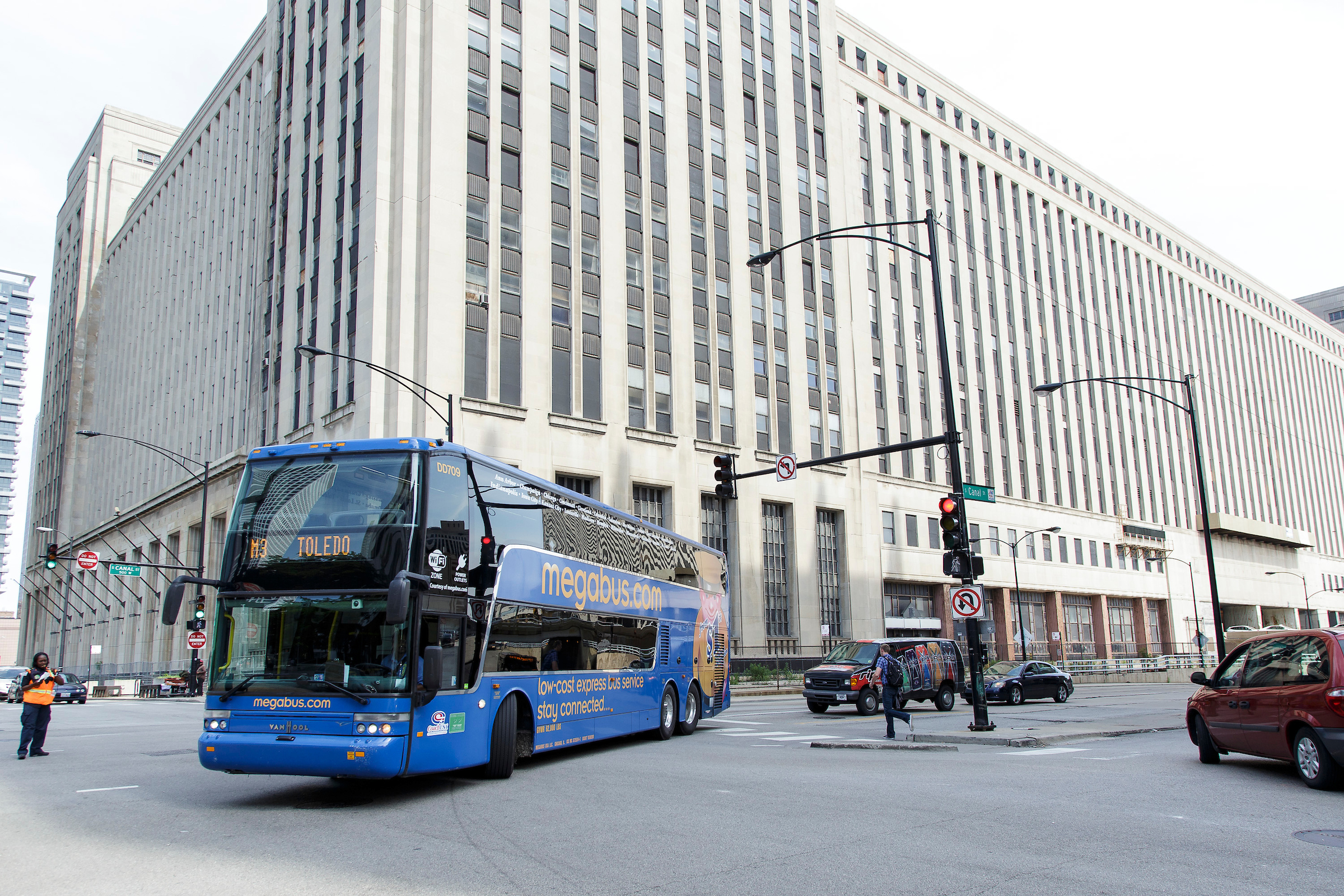 Established bus brands, like Megabus, are hustling to attract customers in 2018, find researchers at the Chaddick Institute for Metropolitan Development. (DePaul University/Jeff Carrion)
Established bus brands, like Megabus, are hustling to attract customers in 2018, find researchers at the Chaddick Institute for Metropolitan Development. (DePaul University/Jeff Carrion)CHICAGO — After being financially hurt for several years by cheap fuel prices and a soft economy, intercity bus lines rolled into the new year with renewed momentum, find researchers at DePaul University’s Chaddick Institute for Metropolitan Development.
“Economic growth paved the way for new services, while luxury options and tech-oriented transformations push the sector in exciting new directions,” said Joseph Schwieterman, director of the institute and lead author of the study. Brian Antolin, industry expert and a research affiliate at the institute, is co-author of the study. The researchers outlined trends including:
- Business-class and luxury bus services are growing to destinations that have not yet had a taste of these offerings, particularly in Florida, New England, the Northeast and Texas. These services will increasingly offer reserved seating, comparable to that on most airlines.
- Tech-oriented bus lines and startups are using crowdsourcing and dynamic scheduling to attract new markets. Services Rally Bus and Skedaddle operate only when enough travelers express a willingness to pay for a set route and time.
- Guaranteed seating and e-tickets are becoming universal on all major bus lines, with Greyhound and Peter Pan rolling out e-tickets last year.
- There is a strong push by public agencies to coordinate intercity bus and rail service. Bus lines are also making greater use of public transit terminals, resulting in the closure of many traditional intercity bus stations.
.jpg) Greyhound rolled out e-ticketing in 2017 to stay competitive in the intercity bus-market. Technology will continue to drive trends in the intercity bus industry in 2018, predict DePaul University researchers. (DePaul University/Jeff Carrion) Established bus companies hustle to attract customers
Greyhound rolled out e-ticketing in 2017 to stay competitive in the intercity bus-market. Technology will continue to drive trends in the intercity bus industry in 2018, predict DePaul University researchers. (DePaul University/Jeff Carrion) Established bus companies hustle to attract customers
More than two dozen new services became available during 2017. Several of the standby brands including BoltBus, Go Buses and Megabus launched service to several new cities, the study authors found. Greyhound Lines introduced extensive new schedules in the Northeast following the termination of its longtime agreement to coordinate schedules with Peter Pan Bus Lines. Premium services, including business-class offerings, are being rolled out in a particularly intensive way by carriers seeking to capitalize on the airport “hassle factor” and a desire to avoid driving amid worsening congestion. Five established carriers rolled out premium services, creating new travel options in many parts of the country for those who would otherwise fly, drive or take the train.
“America’s scheduled bus lines, after hitting a rough patch, are again on the move and adopting some surprising strategies to attract new customers,” noted Schwieterman. “Competition is as brisk as ever.”
Luxury ‘private sleeping cabins’ come to the bus market
The most heavily publicized new service of the year, Cabin, launched in California in July 2017, with service from Santa Monica and San Francisco. Originally piloted in 2016 as “Sleepbus,” Cabin describes itself as a moving hotel, having “private sleeping cabins” that allow passengers to lie flat while also having onboard lounges with conventional seating. Cabin’s attendants work to keep passengers comfortable while also positioning it as a lifestyle and hospitality brand. “Cabin represents a bold experiment away from the standard seating configuration used by other premium providers,” noted co-author Antolin. “By positioning itself as a hospitality brand, it charts a new course for attracting more affluent clientele,” he added.
Tech enters the intercity bus market
Technological innovation, meanwhile, is pushing scheduled intercity bus travel in important new directions, explained Schwieterman. Ticket aggregator sites like Wanderu are becoming platforms of innovation, making it easier for customers to book motor coach travel. These sites are also making new pop-up services possible, such as that offered by OurBus, one of the fastest-growing startups of the year. Crowdsourced services and innovations involving transportation network companies, such as Lyft and Uber, are emerging as change agents. “As more consumers turn to apps to make travel decisions, intercity bus operators are learning how to play the game, which means informing potential customers about ways to avoid the congestion of airports and the tedium of driving,” said Schwieterman.
Trains and buses on one ticket
Small communities are seeing similar changes, researchers found. Enhanced coordination between Amtrak and motor coach lines indicates that both types of transportation providers realize untapped potential in bus-train transfers as part of the Amtrak Thruway bus program. Thruway service allows passengers to buy tickets involving bus-rail connections with a single click, said Antolin. “States are ramping up their efforts to create feeder bus service that support passenger-train routes,” he noted. “Integrating bus and train service is an effective way for governments to stretch budgets in a time of great fiscal stress.”
The full report, “Driving Demand: 2018 Outlook for the Intercity Bus Industry in the United States,” is available for download at http://bit.ly/chaddickDPUrsrch.
###
Sources:
Joseph Schwieterman
jschwiet@depaul.edu
312-362-5732
Brian Antolin
chaddick@depaul.edu
Media Contact:
Kristin Claes Mathews
kristin.mathews@depaul.edu
312-362-7735